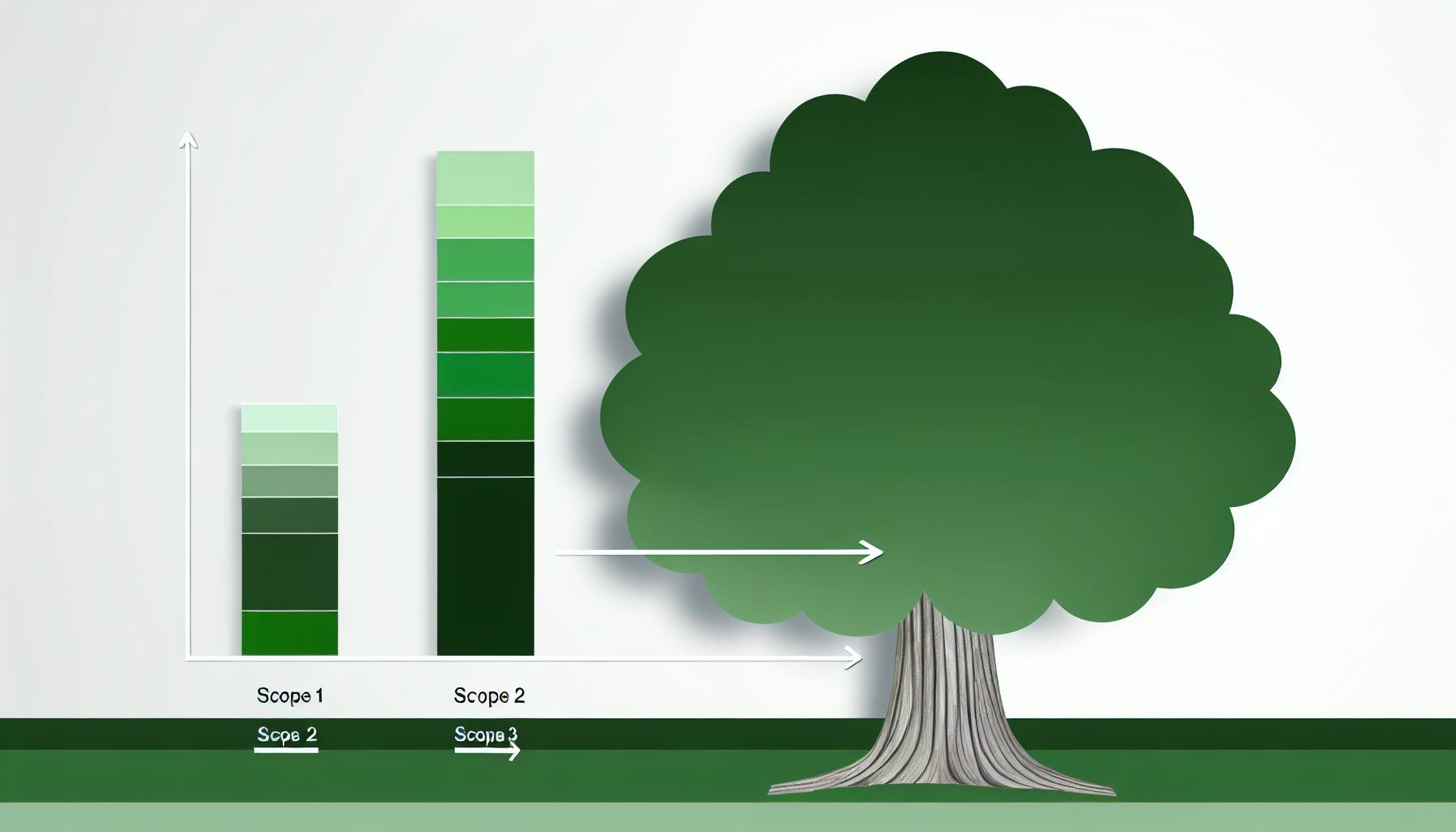Most companies would likely agree that accurately calculating their carbon footprint can be an extremely challenging task.
But by leveraging innovative SaaS tools, even small and medium-sized businesses can streamline carbon accounting - ensuring precise tracking and transparent reporting of their environmental impact.
In this article, we will explore practical strategies to integrate sustainable technologies, simplify emissions calculations, and effectively communicate your organization's eco-conscious efforts.
Introduction to the Carbon Footprint of a Business
As businesses increasingly commit to environmental sustainability and reducing their climate impact, understanding their total carbon footprint has become essential. A company's carbon footprint refers to the total greenhouse gases emitted directly or indirectly from its operations and value chain. Tracking this helps quantify environmental impact, identify high-emission areas, and create effective emissions reduction strategies.
For small and medium enterprises (SMEs), calculating an accurate carbon footprint can be challenging without the right tools. EcoHedge's automated software solutions are designed specifically for SMEs to seamlessly measure, monitor, and report emissions data as per global GHG protocol standards. By integrating EcoHedge's carbon accounting tools, companies can gain the following benefits:
- Hassle-free tracking: Automated data collection and analysis eliminates manual carbon accounting complexities. Customized tracking as per inventory, facilities, transport modes means less effort but comprehensive insights.
- Compliance assurance: Demonstrate sustainability compliance by reporting accurate, auditable GHG inventories and emission reductions to investors and regulators.
- Stakeholder engagement: Share sustainability reports with stakeholders to showcase commitment, seek support for initiatives, and collaboratively reduce collective footprint.
With growing stakeholder pressures and net-zero policy deadlines, SMEs must urgently streamline carbon reporting. EcoHedge enables just that - making carbon footprint tracking simple yet robust through flexible SaaS solutions.
What is the average carbon footprint of a business?
Every business has a carbon footprint, which measures its impact on the environment from greenhouse gas emissions.
According to the EPA, an SME office-based business with around 10 employees emits an average of 3.7 metric tons of carbon dioxide equivalent (tCO2e) per employee annually.
This assumes the business uses:
- Conventional electricity from the grid to power office lighting, computers, printers, etc.
- Natural gas heating and cooling systems for temperature control
Factors that contribute to a higher than average carbon footprint include:
- Energy inefficient office space
- Lots of business travel by car or air
- High paper usage
Businesses with lower footprints tend to utilize renewable energy, encourage remote work, or purchase carbon offsets.
Accurately calculating your carbon footprint is the critical first step to implementing reduction strategies and boosting the sustainability of your operations. Tools like EcoHedge Lifecycle provide automated footprint analysis tailored to your business needs.
How do you calculate carbon footprint of a business?
Calculating the carbon footprint of a business can seem daunting, but the basic formula is simple:
Carbon Footprint = Activity Data x Emission Factor
The activity data refers to the consumption or usage data related to your business operations - such as energy usage, materials purchased, waste generated etc.
The emission factor is a multiplier that translates the activity data into the equivalent carbon dioxide emissions. Emission factors are available from various databases and standards.
For example, if your business used 10,000 kWh of electricity last year, and the emission factor for grid electricity in your region is 0.5 kg CO2e/kWh, then your carbon footprint from electricity usage would be:
10,000 kWh x 0.5 kg CO2e/kWh = 5,000 kg CO2e
There are a few well-established methodologies for calculating your carbon footprint at an organizational level:
- GHG Protocol: A comprehensive, globally recognized standard with separate approaches for calculating Scope 1, 2 and 3 emissions.
- ISO 14064: Very similar to the GHG Protocol but goes into more procedural detail on inventory design, boundaries etc.
- Carbon Trust: A simplified footprint and certification targeted at small-medium businesses in the UK.
The key is to clearly define your organizational boundaries - which parts of your company to include - and set a timeframe e.g annual reporting.
Consistently applying one of these standards over time allows you to track your carbon footprint year-on-year and monitor the impact of any reduction activities. Integrating a purpose-built carbon accounting platform like EcoHedge greatly simplifies this process through automated data collection and insightful reporting.
By following established good practice on carbon footprinting, businesses can accurately quantify their environmental impact, identify hotspots, and engage meaningfully with stakeholders on sustainability efforts aligned to global climate goals. The first step is measurement using a standardized methodology.
What is an example of a company's carbon footprint?
A company's carbon footprint refers to the total greenhouse gas emissions caused directly and indirectly by its operations. Some typical examples include:
Energy consumption
- Electricity used to power facilities and equipment
- Fuels like natural gas or propane used for heating/cooling buildings
Facility managers usually have the most access to energy consumption data through utility bills and meter readings. Finance or procurement teams also regularly review this information when paying invoices.
For most companies, energy use makes up a major part of their carbon footprint. Switching to renewable energy sources like solar or wind can significantly reduce emissions.
Transportation
- Fuel used for company vehicles
- Business travel via planes, trains, etc.
Tracking transportation emissions involves collecting data on fuel/mileage for owned vehicles and employee travel through expense reporting systems. Consider if public transportation or electric vehicles could reduce your footprint.
Waste
- Methane emissions from waste sent to landfills
Work with your waste management provider to get reports on waste volumes and recycling rates. Consider a composting program to divert food waste, which lowers landfill emissions.
Regularly analyzing your company's carbon footprint by these categories identifies the best opportunities to implement sustainability initiatives that reduce environmental impact.
What business has the highest carbon footprint?
Businesses in the energy and utility sectors tend to have the largest carbon footprints. According to the Greenhouse 100 Ranking, the company with the highest emissions in 2020 was Vistra Energy, with over 95 million metric tons of CO2 equivalent.
Vistra Energy is a holding company for power generation and mining assets. Other top emitters are also major utility providers like Duke Energy, Southern Company, and Berkshire Hathaway Energy. These companies rely heavily on fossil fuels to generate electricity, which produces substantial greenhouse gas emissions.
The scale of emissions from the energy sector underscores the importance and challenge of decarbonizing our power grids. As the world transitions to renewable energy, power companies have begun setting ambitious emissions reduction targets. For example, Duke Energy aims to reach net-zero carbon emissions by 2050.
Small and medium enterprises (SMEs) naturally have smaller carbon footprints than massive utility companies. But every business produces some level of emissions and should measure its environmental impact. Understanding your company's carbon footprint is the first step to managing and reducing it over time.
sbb-itb-919600f
Laying the Groundwork: How to Measure Carbon Emissions
Measuring a company's carbon footprint is an essential first step towards reducing environmental impact and meeting sustainability goals. However, the process can seem daunting, especially for small and medium-sized enterprises (SMEs). This section explores practical strategies and helpful tools to simplify carbon accounting for businesses.
The ABCs of Company Carbon Footprint Reporting
- Accurate - Obtain precise data across all emission sources to avoid underreporting. Clearly define inventory boundaries and ensure consistent measurement methodologies year-over-year.
- Comprehensive - Account for the major greenhouse gas (GHG) emission scopes:
- Scope 1 - Direct emissions from owned/controlled sources like company vehicles and equipment.
- Scope 2 - Indirect emissions from purchased electricity and heating.
- Scope 3 - Value chain emissions from business travel, waste disposal, etc.
- Balanced - Give equal attention to all scopes based on their contribution to total footprint. Don't overlook Scope 3 just because data collection can be more difficult.
Adhering to leading carbon accounting frameworks like the Greenhouse Gas Protocol brings discipline and consistency to the reporting process.
Exploring Small Business Carbon Footprint Challenges
For SMEs, dedicating resources to measure emissions can be daunting amidst competing priorities. Common pain points include:
- Obtaining granular data across all scopes
- Parsing through complex methodologies and carbon jargon
- Justifying investments for future cost savings and risk mitigation
However, SMEs also have advantages in their flexibility and connectedness with employees to drive grassroots engagement on sustainability initiatives.
Tool Time: Utilizing a Free Carbon Footprint Calculator for Business
General-purpose carbon calculators offer a convenient starting point to estimate emissions:
Benefits
- Quick, free, user-friendly
- Raise awareness on largest emission sources
- Simplify data collection
Limitations
- Less accurate without company-specific data
- Limited to certain scopes and industries
- Lack robust reporting capabilities
For more customized insights, SMEs should graduate to specialized business carbon accounting solutions like EcoHedge. Our SaaS platform seamlessly tracks all emission sources, ensures compliance with the latest standards, and generates dynamic reports to engage stakeholders. The end-to-end automation simplifies your net zero journey.
Reducing Emissions: Practical Carbon Footprint Examples
As businesses seek to reduce their environmental impact, measuring and lowering their carbon footprint is a practical first step. This section explores real-world examples of how companies have successfully tracked and reduced their emissions through carbon accounting.
Spotlight on Success: A Company Footprint Example
Consider the experience of EcoGoods, a small ecommerce company selling sustainable products. As part of its net-zero emissions goal, EcoGoods needed to fully understand its carbon footprint across business operations.
By using the EcoHedge Lifecycle carbon accounting software, EcoGoods was able to automatically calculate its carbon footprint based on key inputs like energy usage, supply chain activities, transportation mileage, and more. The software integrated seamlessly with the company's existing tools through API connections.
EcoGoods discovered that 63% of its emissions came from third-party shipping and fulfillment services. To address this, EcoGoods switched carriers to ones using electric vehicles for deliveries. They also optimized packaging to reduce materials and size.
Over a year, these carbon reduction strategies lowered EcoGoods' emissions by 51% - putting the company firmly on track towards carbon neutrality. The carbon footprint reporting and stakeholder engagement features in EcoHedge's platform were pivotal in getting buy-in across the organization to double down on sustainability initiatives.
EcoGoods' example demonstrates the power of leveraging carbon accounting software to establish an emissions baseline, identify hotspots, and implement targeted carbon reduction actions. For small and medium businesses new to measuring their company footprint, the hands-off automation and easy-to-understand tracking abilities of tools like EcoHedge Express can provide the perfect starting point.
Streamlining Your Strategy with Sustainable Innovations
Today's businesses are faced with increasing pressure to measure, report, and reduce their environmental impact. For small and medium-sized enterprises (SMEs), navigating the complexities of carbon accounting can be daunting. However, by integrating software tools purpose-built for sustainability, companies can streamline their carbon management strategy.
Simplifying the Process from Start to Finish
Calculating your company's carbon footprint is the critical first step to curbing emissions. Typically, this requires collecting large volumes of operational data across facilities, supply chains, and more. Without proper tools, assembling this information into a greenhouse gas inventory based on accepted methodologies like the Greenhouse Gas Protocol can be incredibly labor-intensive.
Luckily, forward-looking solutions are eliminating these pain points through process automation. With the ability to connect data sources using APIs and intelligently process the information, carbon footprint measurement is now as simple as the push of a button. And by leveraging benchmark databases on emission factors tailored to your company's industry sector, these platforms generate high-fidelity carbon accounting specific to your operations.
Streamlining data collection and analysis means more time focused on executing carbon reduction initiatives across your organization. From there, advanced software even allows custom tracking of these mitigation activities and modeling of different decarbonization scenarios. With sustainability management taken care of, you're empowered to confidently pursue your net-zero emissions goals.
Engaging Stakeholders Through Robust Reporting
Once you've calculated your overall and supply chain carbon footprints with a reliable methodology, clearly communicating performance to stakeholders is critical. Investors, customers, regulators, and employees are increasingly demanding enhanced environmental transparency.
Configuring visually compelling reports covering greenhouse gas inventories, progress to targets, and reduction plans demonstrate your commitment to sustainability. More importantly, they foster deeper engagement both internally and externally around shared climate objectives.
Sophisticated tools meant for carbon management excel in this regard by automatically generating presentation-ready reporting aligned to popular disclosure frameworks. This includes standards like CDP and TCFD catered to investor needs. With just a few clicks, you can export customizable reports to share via online portals, opening impactful stakeholder dialogues on your decarbonization journey.
Planning for Continuous Improvement
The path to net-zero requires persistent iteration as new technologies, regulations, and business factors emerge. As such, integrating lean processes that continually enhance your sustainability program is key.
Cutting-edge software enables this through built-in tracking of emission sources, reduction initiatives, and actual vs projected performance over time. You gain complete visibility allowing adjustments to be made, ensuring carbon accounting accuracy and consistency improves each cycle.
These platforms also help future-proof strategies by automatically updating emission factors, calculation methodologies, and reporting templates as standards evolve. With the foundation for continuous enhancement laid, focusing efforts on scaling impact becomes clearer.
By leveraging purpose-built solutions combining automation, flexibility, and stakeholder engagement, the carbon management process is no longer a burden but an opportunity to drive competitive advantage. SMEs can now seamlessly strengthen climate initiatives, building resilience and growth for the long term.
Telling Your Eco-Story: Marketing Your Green Initiatives
Reducing your company's carbon footprint is an admirable goal that demonstrates social responsibility and environmental stewardship. However, the impact of your sustainability efforts should not end there. Communicating your carbon reduction strategies and progress made is crucial for further driving change.
Marketing your green initiatives serves multiple purposes:
Building Trust and Credibility
Promoting your carbon accounting and ecological impact transparency helps build trust and credibility amongst key stakeholders. Customers and investors are increasingly basing decisions on corporate sustainability performance. Communicating your sustainability metrics and strategies shows you have nothing to hide and are committed to ethical operations.
Some ideas for marketing your emissions tracking and reduction include:
- Publish an annual sustainability report clearly outlining carbon footprint over time and reduction targets. Compare against industry benchmarks.
- Create an engaging infographic for your website summarizing key eco-stats and showcasing environmental certifications.
- Send customized email campaigns to segmented customer lists highlighting recent green achievements.
Rallying Employees Around a Common Cause
Your company's sustainability goals impact more than just the bottom line. Broadcasting eco-friendly policies and their positive impact can boost employee morale and productivity.
Tactics for inspiring your team include:
- Start all-hands meetings celebrating recent carbon footprint milestones and sharing success stories.
- Gamify green habits through inter-department competitions on usage reduction of electricity, paper, commuting, etc.
- Recognize outstanding contributions by individuals to your net zero pursuit through rewards, shoutouts, and highlighting their work.
Influencing External Stakeholder Decisions
Your sustainability initiatives directly combat climate change on a larger scale. But the story shouldn't end with your individual company. Promoting your carbon accounting journey can motivate other businesses to follow suit.
Ways to lead by example with your eco-branding include:
- Speak at green business conferences and events about implementing carbon tracking software.
- Volunteer your team's expertise through mentoring programs that help SMEs measure environmental impact.
- Publish carbon reduction checklist guides, infographics, and thought leadership content that educates other companies.
The effectiveness of your company's sustainability strategy involves both doing and sharing. While meticulous carbon accounting provides the blueprint, creatively marketing your eco-story builds awareness and momentum for greater collective action against climate change. The best solutions balance technical expertise with resonant storytelling that rallies stakeholders to drive transformation at scale.
Conclusion: Solidifying Your Carbon Conscious Culture
The quest to measure and reduce your business's carbon footprint can seem daunting. However, by taking advantage of user-friendly software like EcoHedge, even small and medium enterprises can simplify the process of carbon accounting, forecasting, and reporting.
This allows you to not only understand and minimize your company's environmental impact, but also effectively engage stakeholders on your sustainability journey. With accurate emissions data at your fingertips, you can:
- Set science-based emission reduction targets
- Pinpoint the biggest hotspots in your operations to reduce
- Make data-driven decisions on sustainability initiatives and investments
- Highlight your achievements and commitment to reducing your carbon footprint
As stakeholders like investors, customers, and regulators expand their focus on measuring environmental, social, and governance (ESG) performance, tools like EcoHedge put the power of robust carbon accounting in your hands. Its seamless integration with your existing finance and operational systems creates a solid foundation from which your company's carbon-conscious culture can flourish.
The result is gaining a competitive edge while future-proofing your business against climate risk - all by simply streamlining your carbon footprint strategy. The time for ambitious and inclusive climate action is now. Let EcoHedge help drive and support your organization's sustainability journey today.



